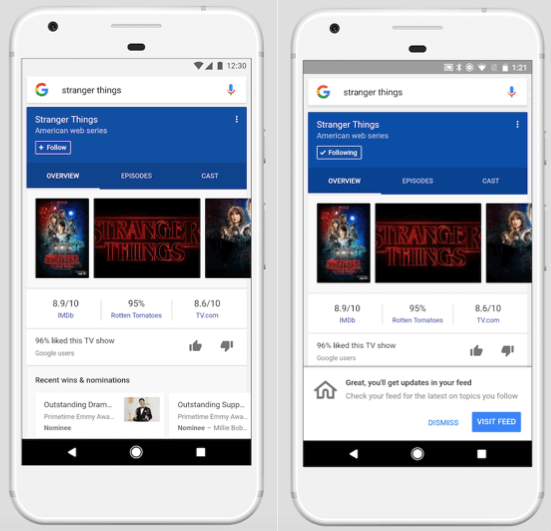Google Now is dead, long live ‘the feed’
Google is killing the 'Google Now' name but improving the underlying functionality to make it more controllable, engaging -- and searchable.

Google Now was launched at Google I/O in June 2012. It was part of a package of updates and UI changes for mobile search, which included a female-voiced mobile assistant to compete with Apple’s Siri.
Google Now was initially a way to get contextually relevant information based on location, time of day and your calendar. It evolved to become much more sophisticated and elaborate, with a wide array of content categories delivered on cards. For a time it was being called “predictive search,” although that term has faded.
Now was billed as a way to get information on your smartphone without actively searching for it. It was heralded by some as the future of mobile search.
The ‘feed experience’ improves
Today Google is officially killing the “Google Now” brand. It’s not getting rid of the functionality, however. That will remain and is being upgraded with an improved design and some new features, including reciprocal connections between search and your personalized content feed.
Last December, Google introduced a new “feed experience” as part of Google Now, which featured topics in one tab and a second tab for personal information and updates, such as travel plans and meetings. In the rollout today, (Google app for Android and iOS), that two-tab structure is preserved, but the feed is becoming richer and more controllable. The rollout is US only, with international markets happening in the coming weeks.
Users will be able to follow content directly from mobile search results and have that surface on an ongoing basis in their feeds. A new “follow” button will appear in some contexts, as the image above illustrates. However, most content that appears in the feed will still be determined algorithmically, based on search history and engagement with other Google properties such as YouTube.
There will also apparently be some content from locally trending topics. However, that trending content is not based on user contacts or social connections.
At a briefing Tuesday in San Francisco, the Google Team, lead by Ben Gomes, was asked several times about how these changes compared to the Facebook News Feed. The answer was: this is about you and your interests, not topics your friends are engaged with.
Intensity of user interests to be reflected
The specific topics and cards that appear are also being calibrated to reflect the intensity of your interests. If you’re more interested in travel or hip-hop or bike racing than cooking or boxing or art, that will be reflected and emphasized in your feed accordingly. In other words, interest level will be captured.
Google indicated that it will also be easy to unfollow topics: “Just tap on a given card in your feed or visit your Google app settings.” And, of course, as the company’s blog post asserts, “The more you use Google, the better your feed will be.”
Perhaps most interesting, from a “search” perspective, is that every card will have a header that will be able to initiate a mobile search with a tap. That wasn’t possible with Google Now. Thus there’s a feedback loop of sorts: search results can be followed, feed content can be searched.
It’s very much in Google’s interest to build products that keep the brand and some version of search in front of mobile users throughout the day. But Google is also trying to improve upon Now as a product, even as it gets rid of that name.
‘Vast majority’ of queries now mobile
Gomes said during the briefing that the “vast majority of our queries come from mobile.” Obviously, Google has very successfully transitioned to mobile, which wasn’t a foregone conclusion. Now it wants to give users more reasons to check in daily and new pathways into search. It’s not clear how widely Now was being used by the bulk of Google’s mobile audience.
Beyond the mobile app experience, Google said that it would be bringing the feed to the desktop version of the Chrome in the near future, though it didn’t show that off. I’m imagining it as the reincarnation of iGoogle, a personalized start page that was shuttered in 2012 — the same year Now was introduced.
Contributing authors are invited to create content for Search Engine Land and are chosen for their expertise and contribution to the search community. Our contributors work under the oversight of the editorial staff and contributions are checked for quality and relevance to our readers. The opinions they express are their own.
Related stories
New on Search Engine Land
